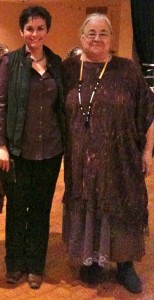 |
| Filmmaker Beth Nelson and Suscol Council Executive Director Charlie Toledo on Opening Night. |
Napa Valley Opera House was well populated Tuesday evening, February 19, 2013, for the premier showing of two locally produced films: Awakening Healing Voices of Our Ancestors: A Destiny Reclaimed and The Sky is the Roof. Filmmaker Beth Nelson, Tewa and Cherokee, and Suscol Council Executive Director Charlie Toledo, Towa, documented history generally untold until recently, that of the demise of the Native American populations of the Napa Valley. One of the areas most densely populated in North America with 30,000 to 40,000 people, the land was “a cultivated paradise.” Then with the arrival of General Vallejo in 1833, the native populations of Mayakmah, Mutistul, Mishewal, and Onastis were greatly diminished through small pox and “Indian campaigns,” i.e., forced marches and battles.
The first film opens at the Pow Wow held in Yountville near the Veteran’s home on one of the last Indian war battlegrounds upon which many Indians were killed. In the background one hears drumming and singing, watches family groups arriving, dancing, generally enjoying the sun and the day. Attendees are interviewed, and stories of the older times told. One feels the heartfelt sentiment of celebration of life and family, as well as grief for what has been lost.
At intermission Charlie explained that the Pow Wow will be held on this spot a total of 10 years to heal the land and the injury perpetrated there. She also explained that the first Pow Wow in recent times was held for ten years on the grounds of the Napa Valley Junior College upon which the Spanish army had camped before beginning their onslaught war on the native populations.
That is how I felt Tuesday evening as these lovely young dancers from our Americas entered, dancing the steps of their ancestors, bringing through song and movement the medicine healing of love and generosity of gifting, even to the descendants of their invaders. Afterwards Charlie introduced the drummers and dancers who represented the Pomos, Lakota, Hupa, Aztec-a, and other tribes. In a country formed with the stated purpose of freedom of religion, one can only wonder at the fact that until 1980 it was illegal for these peoples to dance their ancestors’ dances and sing their songs and prayers in public.
The second movie documented the severity of the water problem, and how European invasion into the valley has created an imbalance that will result in severe water shortage if changes are not made very soon. Charlie termed the movie “controversial.” Watching the footage of the concrete lined banks of the river done through funding for flood control, I see what she means. Charlie’s suggestions to the Flood Control Board about using native cottonwood, willow, and other natural flood control plantings were largely ignored by officials. It brings up the importance of reclaiming what knowledge is still available in these broken lineages of peoples whose ancestors lived here in balance with these forests, meadows, and rivers.
I am haunted by the clips of a mallard duck swimming alongside an orange plastic construction fence in the section of the river that we now call Oxbow, an area that was one of the most sacred areas to native peoples in the Valley. We are so used to the western European way of construction and domination that we cannot even see the craziness. The duck seems confused as it swims along the plastic fence, perhaps looking for a hole to climb onto land. One hopes that we can open ourselves to knowledge that we desperately need to survive the environmental crisis that is upon us, knowledge of a gentler way.
We owe activists and visionaries Charlie Toledo and Beth Nelsen our gratitude in bringing into the collective this knowledge of the ancestors who lived on this land and loved it for millennia. It just might be knowledge that can save us.
